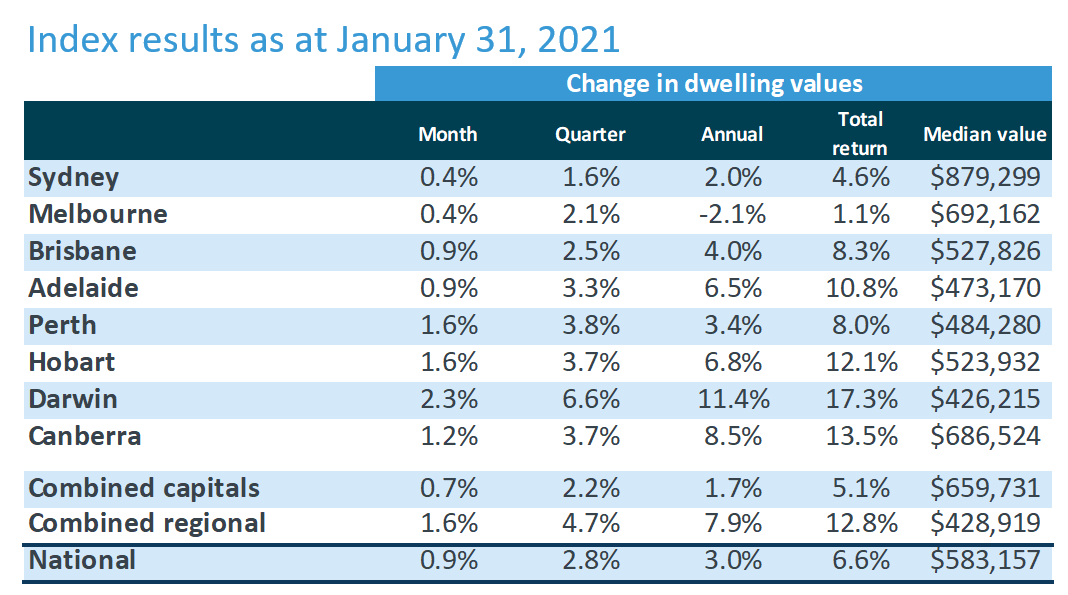Source: Corelogic
Housing values continued to rise through the first month of 2021 with CoreLogic's national home value index up 0.9% over the month. The January movement takes Australian home values to a fresh record high. Housing values have surpassed pre-COVID levels by 1.0%, and the index is 0.7% higher than the previous October 2017 peak.
Every capital city and broad rest-of-state region recorded a rise in housing values over the month, ranging from a 2.3% surge across Darwin to a relatively mild 0.4% rise in Sydney and Melbourne.
Continuing a trend that became evident early in the pandemic, regional housing values rose at more than twice the pace of the capital city markets. CoreLogic's combined regionals index was up 1.6% over the month, while capital city values were 0.7% higher. Since the onset of COVID-19 in March last year, regional housing values have surged 6.5% higher while capital city housing values are down -0.2% over the same time frame.
The largest states are seeing regional home values rising at more than three times the pace of their capital city counterparts. Home values across Regional Victoria and Regional New South Wales rose 1.6% and 1.5% respectively in January compared with a 0.4% increase in home values across Melbourne and Sydney.
According to CoreLogic's research director, Tim Lawless, the divergence between metro and regional housing demand in New South Wales and Victoria is more substantial than in other states. "Internal migration data shows more people are leaving Sydney and Melbourne for regional areas, resulting in a transition of activity from the metro regions to the outer fringe and regional markets. This demographic trend is further compounded by the demand shock of stalled overseas migration. As Melbourne and Sydney historically receive the vast majority of overseas migrants, these metro areas have been the hardest hit by this demand shock."
"Better housing affordability, an opportunity for a lifestyle upgrade and lower density housing options are other factors that might be contributing to this trend, along with the new found popularity of remote working arrangements."
Another broad trend that is becoming increasingly evident is the outperformance of houses over units. At a national level, house values have risen by 3.5% over the past six months while unit values are unchanged. More recently, the past three months has seen every capital city record a stronger result for houses over units.
"Demand for units has diminished through COVID-19 amidst record low levels of investor participation and changing living preferences. At the same time supply levels are heightened in some precincts. While demand and supply remain imbalanced we are likely to see units continue to underperform relative to detached housing markets," Mr Lawless said.

The rental market dynamic has changed substantially through COVID but there are some early signs that weakness across the unit sector is starting to level out, if not turn around.
Rental demand has transitioned towards detached and lower density housing markets since the pandemic, partly reflecting the disruption to rental demand from overseas migration, but also the stress of changed working conditions, caused by COVID restrictions, in industry sectors that are traditionally more aligned with rental demand. Additionally, with more people working from home, demand for larger housing options has lifted.
Unit rents in Melbourne and Sydney are down 7.8% and 5.6% respectively over the past year, but in some positive news for landlords, the rate of decline is easing across these markets; in fact Sydney unit rents posted the first month-on-month rise in January (+0.8%) since March last year and Melbourne unit rents held firm over the month. Unit rents across Brisbane and Hobart have also been on a downwards trajectory through COVID, however recent months have shown a similar trend of rising rents as conditions start to stabilise.





